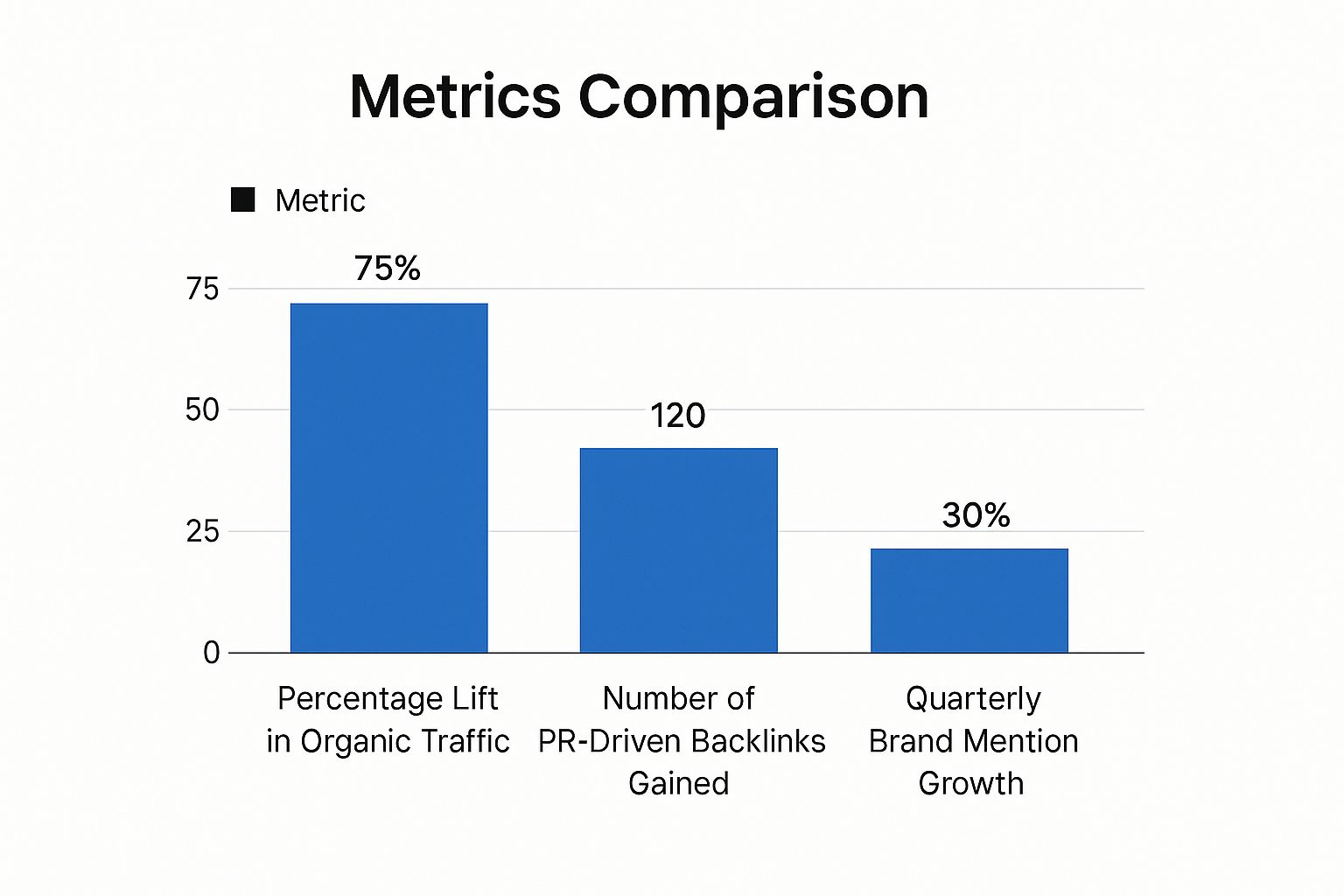
Pr and SEO: Boost Your Brand with Strategic Integration
The Powerful Intersection of PR and SEO
For years, public relations and SEO were seen as distinct disciplines. PR professionals focused on building relationships and brand reputation, while SEO specialists concentrated on technical website optimization and keyword rankings. But the digital age has brought these two worlds closer, creating a powerful synergy. Modern marketing strategies must understand this intersection to maximize impact.
This synergy occurs when strategic PR directly boosts search visibility. Securing coverage in high-authority publications like the Financial Times not only builds brand awareness, but also generates valuable backlinks. These backlinks are crucial for SEO performance, acting as votes of confidence from other websites. This signals to search engines like Google that your content is credible and deserves a higher ranking.
Increased brand mentions and online buzz from successful PR campaigns also improve brand signals, further enhancing SEO. Imagine the ripple effect of a well-placed article in a respected industry publication. It's not just about reaching a wider audience; it's about establishing your brand as a trusted voice in your field.
The UK Landscape: Challenges and Opportunities
The current state of PR and SEO integration in the UK presents both challenges and opportunities. The latest UK State of Digital Marketing Report for 2025 reveals that 60% of UK businesses have an SEO strategy, highlighting the importance of search engine visibility. Yet, only 36% incorporate off-page SEO –– such as digital PR and link-building –– in their approach. Find more detailed statistics here. This gap represents a significant opportunity for PR professionals to leverage their expertise for SEO gains.
Why Integrate PR and SEO?
Integrating PR and SEO offers compelling advantages for UK businesses:
-
Increased Brand Authority: PR builds trust and credibility, while SEO enhances online visibility, positioning your brand as an industry leader.
-
Improved Search Rankings: High-quality backlinks from PR efforts directly contribute to higher rankings, driving organic traffic to your website.
-
Sustainable Growth: The combined force of PR and SEO creates a powerful long-term strategy for sustained online visibility and business growth.
-
Cost-Effectiveness: Integrating these disciplines is often more efficient than pursuing them separately, maximizing return on investment.
-
Enhanced Brand Storytelling: PR crafts compelling narratives that resonate with audiences, while SEO ensures those stories are discovered by the right people.
Making the Most of the Intersection
To effectively integrate PR and SEO, consider these best practices:
-
Develop a Unified Strategy: Align PR and SEO goals from the start, ensuring both teams work towards common objectives.
-
Focus on Quality Content: Create valuable, engaging content that attracts both media attention and search engine crawlers.
-
Target Relevant Keywords: Strategically incorporate relevant keywords within PR materials to optimize for search visibility.
-
Track and Measure Results: Monitor key metrics like backlink growth, search rankings, and website traffic to evaluate the effectiveness of your integrated strategy.
By embracing the synergy of PR and SEO, UK businesses can unlock significant potential. This integration isn't simply a trend; it's a fundamental shift in modern marketing, enabling brands to build authority, drive organic traffic, and achieve lasting online success.
How Digital PR Transforms Search Performance

Digital PR isn't just about seeing your company name in the news. It's a powerful tool for significantly improving your search performance. This strategic approach to PR creates valuable SEO assets that Google loves. Securing coverage on reputable websites builds authoritative backlinks. These backlinks are like votes of confidence, telling search engines your website offers valuable and trustworthy content.
This trust translates into higher search rankings.
From Media Coverage to Measurable SEO Results
Think of PR as the catalyst that ignites your SEO strategy. A well-executed PR campaign creates a ripple effect online, increasing brand mentions and generating positive buzz. This heightened visibility strengthens your brand signals, a critical factor search engines use when ranking websites. Positive media coverage doesn't just increase brand awareness; it establishes you as an industry leader, driving more organic traffic to your site.
Identifying PR Opportunities with SEO in Mind
To maximize the SEO benefits of your PR, you need to find opportunities that attract media attention and generate valuable backlinks. Data storytelling, trend analysis, and thought leadership are excellent ways to achieve this. For example, a data-driven report on a trending topic in your industry can attract coverage from relevant publications, resulting in high-quality backlinks and improved search rankings. You can also position your brand as a thought leader by sharing insightful commentary and expert opinions. This can secure media placements in authoritative publications, further boosting your SEO performance. Learn more about PR strategies in our article, How to Master Public Relations Strategies.
To help you understand the direct impact of PR work on search rankings, we've created the following table:
PR Activities and Their SEO Benefits
This table shows the relationship between common PR tactics and their specific SEO benefits, helping readers understand the direct impact of PR work on search rankings.
| PR Activity | SEO Benefit | Difficulty Level | Timeframe for Results |
|---|---|---|---|
| Securing guest posts on relevant industry blogs | High-quality backlinks, increased referral traffic | Medium | Medium Term (3-6 months) |
| Creating and distributing press releases about company news and product launches | Increased brand mentions, improved online visibility | Easy | Short Term (1-3 months) |
| Developing data-driven content and pitching it to journalists | Authoritative backlinks from high-domain websites, increased brand authority | Hard | Long Term (6+ months) |
| Engaging in influencer marketing campaigns to promote your brand and content | Increased social media engagement, improved brand awareness, potential backlinks | Medium | Short to Medium Term (1-6 months) |
As you can see, different PR activities offer varying levels of SEO benefits. While some tactics might yield quicker results, others contribute to long-term SEO gains. Choosing the right mix of activities is crucial for a successful PR strategy.
Measuring the Real Impact of PR on Search
Media mentions and brand awareness are valuable, but measuring the tangible SEO impact of your PR is crucial. This means tracking key metrics that reflect the synergy between your PR and SEO efforts. These metrics include:
-
Backlink growth: Monitor the number and quality of backlinks resulting from PR activities.
-
Domain authority: Track your website's overall authority, influenced by your backlink profile.
-
Organic traffic: Measure increases in organic search traffic from PR-driven backlinks.
-
Keyword rankings: Observe improvements in your website's ranking for target keywords.
Analyzing these metrics offers a clear picture of how PR is transforming your search performance. It allows you to refine your PR and SEO strategies, maximizing their impact and demonstrating a return on investment. You can learn more about effective marketing strategies for small businesses here: Effective Marketing Strategy for Small Business Success. This data-driven approach allows you to refine your PR and SEO strategies for maximum impact and demonstrate the return on investment of integrated campaigns.
Navigating the UK PR and SEO Landscape
The UK's digital scene offers a vibrant mix of opportunities and obstacles for integrated PR and SEO. Success hinges on understanding the UK market's subtleties. This means studying consumer behavior, forging strong media connections, and analyzing the competitive landscape across different industries. This allows you to pinpoint what connects with the UK audience and refine your strategies accordingly.
Understanding the UK Digital Consumer
UK consumers increasingly use search engines like Google to find products and services. This underscores the importance of robust SEO practices in reaching your target audience. Optimizing your website and content for relevant keywords, for instance, can dramatically improve your search result visibility. Furthermore, understanding regional differences in UK search behavior can further enhance your targeting efforts.
The Power of Integrated Strategies
Some UK industries are leading the way in integrated PR and SEO, while others lag behind. Those embracing integration are seeing impressive results, such as stronger brand authority and higher search rankings. This integrated approach is especially powerful in competitive sectors where differentiation is paramount. However, successful integration requires careful resource allocation and collaboration between PR and SEO teams. The infographic below showcases the benefits of integrated PR and SEO strategies.

The data reveals a clear link between integrated PR and SEO efforts and improved key performance indicators. The rise in organic traffic, PR-driven backlinks, and brand mention growth demonstrates the effectiveness of this combined approach. This reinforces the idea of PR and SEO not as separate entities, but as complementary forces. The UK SEO market is booming, reaching a value of £19.2 billion by 2023. 42% of UK consumers use search engines to find products and services—far more than those influenced by social media or TV advertising. Want to delve deeper? Find more detailed statistics here.
To illustrate current market dynamics, let's examine some industry-specific data:
PR and SEO Market Growth in the UK
This table presents statistics on market value, job growth, and investment in PR and SEO disciplines across various UK industries.
| Industry Sector | PR Market Value | SEO Market Value | YoY Growth | Integrated Strategy Adoption |
|---|---|---|---|---|
| E-commerce | £3.2B | £4.5B | 15% | 70% |
| Finance | £2.1B | £3.8B | 12% | 60% |
| Healthcare | £1.5B | £2.2B | 8% | 50% |
| Technology | £2.8B | £4.1B | 18% | 75% |
The table above highlights the significant market value of both PR and SEO across various sectors. The technology and e-commerce industries exhibit the highest growth and adoption of integrated strategies. This suggests these sectors recognize the synergistic power of combining PR and SEO.
Adapting to the UK Media Landscape
The UK media landscape has its own unique characteristics. Building strong relationships with UK journalists and understanding their preferences is key to successful PR. Navigating regulatory matters and staying informed about the evolving media environment are also crucial for long-term success. This includes keeping up with changes in media consumption habits and adapting your strategies accordingly. By understanding the specific dynamics of the UK market, you can fine-tune your PR and SEO strategies for maximum impact. This targeted approach is essential for building a solid online presence and reaching your business goals in the competitive UK digital arena.
Creating Content That Captivates Both Media and Search

The intersection of PR and SEO creates a powerful synergy. It's about crafting content that resonates with both journalists and search engines, a delicate balance of compelling storytelling and strategic optimization. Think of it as weaving a narrative that captivates readers while seamlessly incorporating the elements search engines crave. This section explores the frameworks for creating such versatile, dual-purpose content.
Keyword Research for PR Opportunities
Keyword research isn't just for SEO specialists anymore. It's a valuable tool for PR professionals too. By understanding the language used by journalists and your target audience, you can tailor your PR materials to attract media attention and boost search visibility. This empowers your content to be discovered organically by those seeking information related to your brand or industry.
For instance, imagine launching a new fintech product in the UK. Researching keywords like "fintech innovation," "UK financial technology," and "mobile banking solutions" could be highly beneficial.
Structuring Stories for Search Visibility
How you structure your PR stories significantly impacts their search performance. This involves naturally incorporating relevant keywords within the title, headings, and body of your content. Using descriptive anchor text for links also elevates both user experience and SEO.
Instead of linking with generic phrases like "click here," opt for descriptive text that previews the link's destination. This creates a clear path for both readers and search engine crawlers to navigate your content. Learn more in our article about What is Digital PR and Why Your Business Needs It?.
Maintaining Editorial Integrity
While optimizing for search is essential, maintaining editorial integrity is paramount. Your PR materials should always prioritize providing informative, engaging, and valuable content for the reader. This builds trust with your audience and establishes your brand as a credible source. Focus on creating content that genuinely helps your target audience while also incorporating SEO best practices.
When strategizing your PR and SEO approach, understanding the broader business and marketing landscape is key. You might be interested in learning more about developing a marketing strategy for small business growth in the UK. This ensures your messaging aligns with current market trends and resonates with your target demographic.
Extending the Lifespan of PR Wins
A successful PR campaign doesn't end with the initial media buzz. Repurposing your content extends its lifespan and amplifies its impact. A press release can be transformed into a blog post, social media updates, or even an infographic. This broader reach allows you to continue building brand awareness and generating backlinks long after the initial PR push.
Building a Content Ecosystem
Think of your content as an interconnected ecosystem, where each piece contributes to both immediate coverage and long-term search performance. Linking different pieces of content through internal links creates a web of information that is easily navigable for both users and search engines. This interconnected strategy strengthens your overall SEO and positions your brand as a valuable resource hub within your industry. By understanding the synergy between PR and SEO, you can build a robust content strategy that delivers both quick wins and sustainable, long-term growth.
Measuring What Matters: Tracking Integrated Success

Stop second-guessing the power of your combined PR and SEO strategy. This section offers clear frameworks for accurately measuring how PR boosts your SEO results and, ultimately, helps you achieve your business goals. We’ll delve into the essential metrics that illustrate this powerful synergy and how to set benchmarks for your campaigns. After all, you can’t improve what you don’t measure.
Key Metrics for Integrated Success
These key metrics reveal the interconnected relationship between PR and SEO, offering a comprehensive view of your integrated strategy's performance.
-
Backlink Profile Growth: High-quality backlinks are fundamental for strong SEO. Track the number and quality of backlinks earned directly from your PR efforts. Prioritize links from respected, authoritative websites within your industry. This clearly shows how PR directly strengthens your SEO foundation.
-
Domain Authority: Domain authority, a search engine ranking score, predicts how well a website will rank on search engine results pages (SERPs). A strong backlink profile from your PR activities plays a crucial role in improving your domain authority, boosting your website's overall credibility with search engines.
-
Organic Traffic Increase: This metric measures the growth in visitors arriving at your website from search engines like Google. Successful PR that generates valuable backlinks naturally leads to a surge in organic traffic. This highlights how PR drives valuable, unpaid traffic to your site.
-
Keyword Rankings: Monitor your website's ranking for target keywords related to your PR campaigns. When PR activities align with your SEO keyword strategy, you'll see a significant improvement in search visibility for those terms. This underscores how PR amplifies your existing SEO keyword strategy.
-
Brand Mentions and Sentiment: Beyond backlinks, PR generates buzz and discussion around your brand. Track how often your brand is mentioned online, including media coverage and social media. Just as important is understanding the sentiment – is it positive, negative, or neutral? This valuable insight helps gauge public perception of your brand.
Setting Meaningful Benchmarks and Tracking Systems
To ensure your PR efforts effectively enhance your search engine visibility, concentrate on developing high-quality, SEO content. Establishing clear benchmarks is essential. This means setting realistic, measurable targets for each key metric mentioned above. Your benchmarks should directly support your overall business objectives. For example, if your main objective is increasing brand awareness, concentrate your PR efforts on securing coverage in high-traffic publications and track brand mentions as a key metric.
Effective tracking systems are crucial for understanding the full impact of your efforts, from initial coverage to final conversions. Leverage tools like Google Analytics and dedicated SEO platforms to monitor website traffic, keyword rankings, and backlink profiles. Social listening tools provide valuable data on brand mentions and sentiment. This comprehensive data-driven approach allows for informed decision-making and continuous optimization.
Demonstrating ROI and Overcoming Attribution Challenges
One of the biggest challenges in measuring integrated PR and SEO success is attribution – directly connecting PR efforts to specific SEO outcomes. However, by correlating PR activities with increases in organic traffic, backlink growth, and improved keyword rankings, you can demonstrate the power of earned media.
Consider exploring resources like How to master digital marketing for financial services. These resources can help you calculate the return on investment (ROI) of your PR in relation to search visibility. By presenting clear data and explaining the connection between PR activities and tangible business results, you can showcase the true value of an integrated approach to stakeholders. This data-driven strategy proves the undeniable value of integrated PR and SEO in achieving your business objectives.
Building Your Integrated PR and SEO Dream Team
A truly successful integrated PR and SEO strategy needs more than just a solid plan. It needs the right people driving it forward. The very structure of your team—whether in-house, agency-led, or a hybrid—is crucial to achieving impactful results. Let's explore how to build a team that not only understands this integration but truly delivers. We'll draw on real-world examples from thriving UK businesses to examine the team structures propelling their success.
Team Configurations That Work
There's no magic bullet, no one-size-fits-all solution when building your dream team. The ideal setup depends entirely on your unique needs and available resources. However, some common configurations consistently prove effective.
-
In-House Teams: This structure often works well for larger organisations with dedicated internal resources. Having both PR and SEO specialists under one roof streamlines communication and fosters closer collaboration. This direct interaction can lead to a more unified approach. However, building a robust in-house team can be costly and requires substantial internal expertise.
-
Agency Partnerships: For smaller businesses or those lacking specific in-house expertise, partnering with an agency can be a strategic move. Agencies often offer specialized knowledge and a fresh, outside perspective that can revitalize your strategy. Clear communication and well-defined goals are essential for a productive and successful agency partnership.
-
The Hybrid Approach: This model combines the strengths of both in-house teams and agency partnerships, offering a flexible solution. For instance, an organisation might have an in-house SEO specialist but outsource their PR to an agency. This approach allows businesses to tailor their team structure to their specific needs and budget, maximizing efficiency and impact.
Breaking Down Silos and Fostering Collaboration
One of the biggest hurdles in integrating PR and SEO is breaking down the traditional silos that often exist between these two disciplines. True integration requires open communication, a shared vocabulary, and clearly defined roles and responsibilities. Regular meetings and collaborative brainstorming sessions are key to building a unified team.
Think of PR and SEO not as separate entities, but as two sides of the same coin, working in harmony. Both teams should be aligned towards common goals, sharing data and insights to maximize overall impact. For example, the SEO team can provide valuable keyword research data to the PR team to inform their content creation, ensuring relevance and reach. Simultaneously, the PR team can share media coverage data to help the SEO team track backlink growth and monitor brand visibility.
Building a Shared Vocabulary and Implementing Effective Communication
Often, PR and SEO professionals use different terminology, which can create a communication gap. Building a shared vocabulary bridges this gap and fosters a more integrated approach. This involves explaining key terms and concepts to both teams and developing a common language for discussing campaign goals, strategies, and results. Clear workflows and communication protocols are also paramount. This includes establishing regular meetings, defining reporting structures, and using shared project management tools.
Utilizing Practical Tools and Templates for Success
Weekly meetings between PR and SEO teams can help track progress, identify challenges, and adjust strategies as needed. Shared dashboards for monitoring key metrics, like backlink growth, organic traffic, and brand mentions, can also facilitate data-driven decision-making. To put theory into practice and maximize efficiency, utilize collaborative briefs, reporting dashboards, and resource allocation templates. These tools can help your team stay organized and ensure everyone is on the same page, working together towards a common goal.
Ready to elevate your brand's digital presence? Blackbird Digital, a UK-based marketing agency, specializes in integrated PR and SEO strategies. We help businesses achieve measurable results through bespoke campaigns, web presence optimisation, and targeted SEO. Learn more about how we can help you achieve your digital marketing goals.




